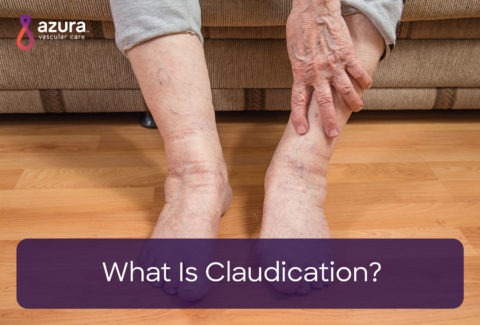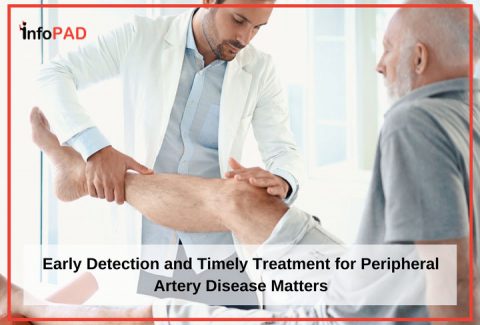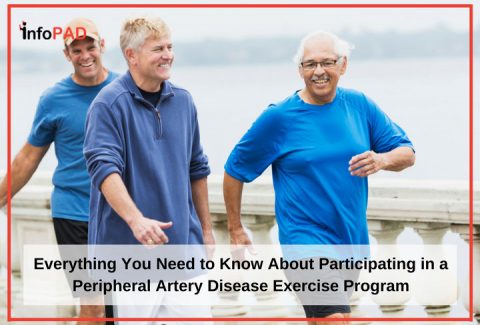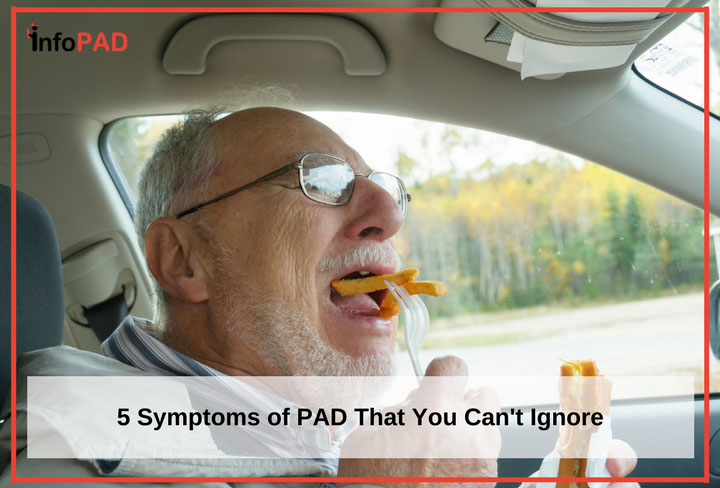
The American Heart Association estimates that there are approximately 8.5 million Americans living with peripheral artery disease (PAD). Identifying PAD in yourself or a loved one can be difficult, since symptoms are often attributed to the normal effects of aging or other pre-existing conditions such as arthritis. It’s important to realize, however, that early diagnosis of PAD is essential, since lifestyle changes and medication can often quickly reduce the pain and discomfort of PAD, and drastically decrease the risk for heart attack and stroke.
What Causes PAD Anyway?
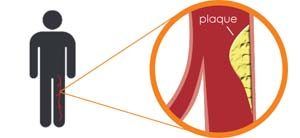 After diagnosis, most patients wonder what causes peripheral artery disease. PAD is caused when arteries clog with fat, calcium, cellular waste and other materials. Like backed-up plumbing in a kitchen sink or bathtub, a narrowing of the arteries restricts blood supply to the legs. Below are the most commonly reported peripheral artery disease symptoms that emerge from this disruption of blood flow, along with diagnosis and treatment information.
After diagnosis, most patients wonder what causes peripheral artery disease. PAD is caused when arteries clog with fat, calcium, cellular waste and other materials. Like backed-up plumbing in a kitchen sink or bathtub, a narrowing of the arteries restricts blood supply to the legs. Below are the most commonly reported peripheral artery disease symptoms that emerge from this disruption of blood flow, along with diagnosis and treatment information.
5 Symptoms of Peripheral Artery Disease
1. Mild to Severe Pain in Legs, Especially after Walking
Physical activity, such as walking or climbing stairs, demands an increased supply of blood to the legs. For people with PAD, clogged arteries often make simple physical activity difficult. Pain, weakness, or numbness in the calves, thighs, or hips that disappears after a few minutes of rest is one of the most frequent PAD symptoms reported by patients. In severe or advanced cases, pain might occur while lying down, but most times, simply dangling your feet over the side of the bed will alleviate the pain.
2. Changes in the Appearance of Your Legs
Before the onset of pain, there are occasionally other noticeable changes in the appearance of the legs. In some cases, you may find:
- The hair on your legs has thinned or disappeared completely
- Your skin starts to appear shiny
- The growth of your toenails has slowed
- The color of one or both of your legs has changed, taking on a bluish tinge
- Your legs seem colder than other body parts, like your arms.
Restricted blood flow can lead to coldness in your lower legs and feet—if you’ve found you need more layers of clothing that seem necessary on your lower extremities, you may be experiencing early symptoms of PAD.
3. Sores on Lower Extremities That Will Not Heal
Healing wounds and fighting infections both require a healthy blood supply, so injuries must be monitored carefully in patients who are at risk for PAD. In extreme cases, a neglected wound can become infected, resulting in death of soft tissue and requiring amputation. Painful dry, gray, or black sores could be signs of either severe peripheral artery disease or another condition that should be examined by a doctor as soon as possible.
4. Symptoms Appear or Worsen When Taking Cold or Allergy Medication
Cold and allergy medications that contain pseudoephedrine (found in OTC medications such as Sudafed®, Advil® Cold and Sinus, Claritin-D®, Tylenol® Cold, etc.) work by constricting blood vessels and allowing less fluid to enter the sinuses, nose, and throat. This constriction can worsen PAD symptoms by constricting arteries that are already clogged with fat, further narrowing the amount of space for blood flow.
5. Enhanced Risk for Peripheral Artery Disease
The last symptom is perhaps the most frightening, because there are often no symptoms at all—in fact, recent studies have reported that as many as 75% of patients with peripheral artery disease do not report having any symptoms. In this case, it’s important to understand some of the high-risk factors that contribute to PAD, such as:
- Chronic Kidney Disease
- Obesity
- Over the age of 70 or age 50 and older with a history of high blood pressure, high cholesterol, diabetes or smoking
- Family history of PAD, heart attack, or stroke.
If one or more of these risk factors are present, you should ask your doctor about peripheral artery disease.
What To Do If You Are Experiencing These Symptoms
There are a variety of resources available to assess the risk for peripheral artery disease, but early diagnosis is critical. Patients with PAD are four times more likely to have a heart attack or stroke, and treatments have been shown to be most effective when PAD is detected early by a physician. If you are experiencing symptoms of peripheral artery disease, you should contact a PAD specialist. Or, complete this questionnaire for a personalized risk assessment and recommendations for next steps.
Incidence of peripheral artery disease is dramatically increasing worldwide – from 164 million in the year 2000 to 202 million in the year 2010. PAD can be hard to detect at home, but it’s easily diagnosed in a clinical setting. If it’s determined that you do have PAD, it can often be managed quickly and effectively—you’ll want to discuss PAD treatment options with your doctor as soon as possible after your diagnosis.
